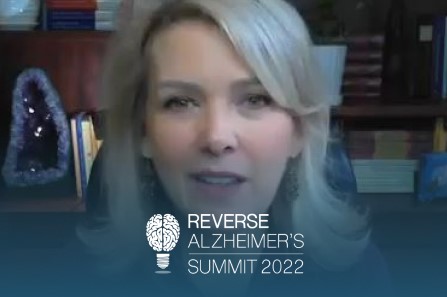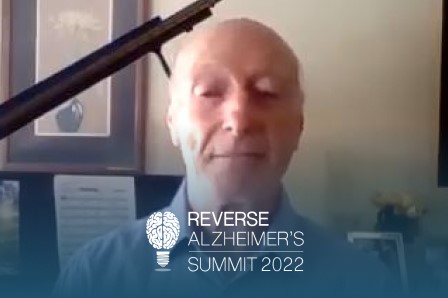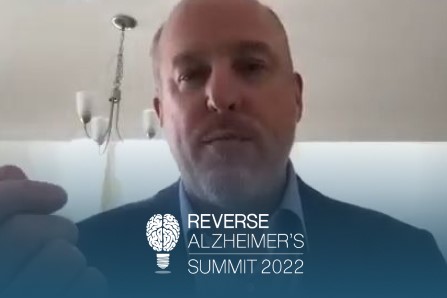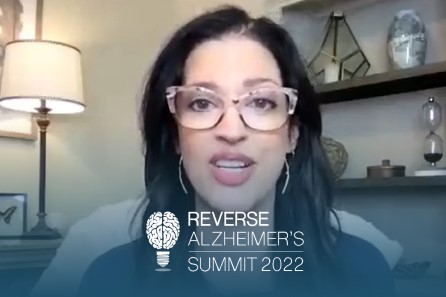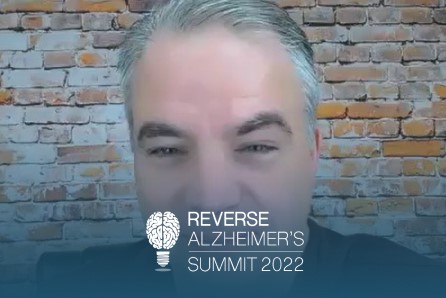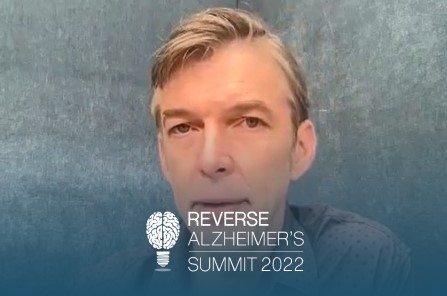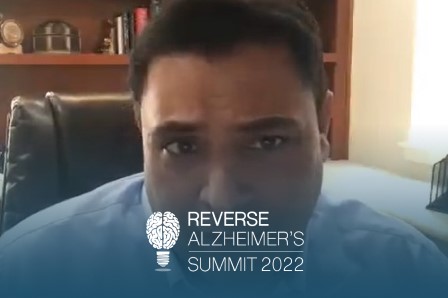Join the discussion below

Dr. Heather Sandison is the founder of Solcere Health Clinic and Marama, the first residential care facility for the elderly of its kind. At Solcere, Dr. Sandison and her team of doctors and health coaches focus primarily on supporting patients looking to optimize cognitive function, prevent mental decline, and reverse... Read More
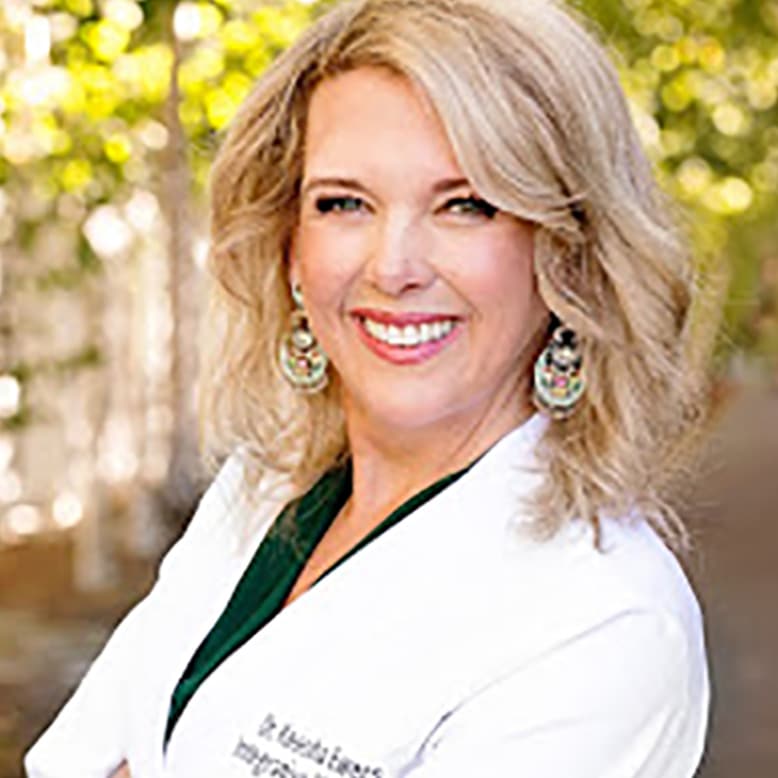
Keesha Ewers, PhD, ARNP-FNP-C, AAP, IFM-C
Dr. Keesha Ewers is an integrative medicine expert, Doctor of Sexology, Family Practice ARNP, Psychotherapist, herbalist, is board certified in functional medicine and Ayurvedic medicine, and is the founder and medical director of the Academy for Integrative Medicine Health Coach Certification Program. Dr. Keesha has been in the medical field... Read More
- How Trauma Affects Your Brain.
- How Trauma Affects Your Behavior Patterns (and How to Change all of it).
- How we revert to our child brain center when our trauma buttons are “pushed”.
Heather Sandison, N.D.
Welcome back to the Reverse Alzheimer’s Summit. I’m your host, Dr. Heather Sandison, and I’m so pleased to have my friend Dr. Keesha back with us. Keesha Ewers, PhD, MSN, ARNP, FNPc is an integrative medicine expert, doctor of sexology, family practice, ARNP, psychotherapist, herbalist, and is board certified in functional medicine and ayurvedic medicine. Plus she’s the founder and medical director of the Academy for Integrative Medicine, Health Coach Certification Program. Dr. Keesha has been in the medical field for over 30 years. After conducting the HURT Study in 2013, Healing Unresolved Trauma, she developed the HURT Model for understanding how past childhood trauma impacts adult health. And as we all know, childhood trauma can impact our risk and stress through our lives, can impact our risk of developing dementia. This led her to the creation of You Unbroken, an online program for patients to heal their own trauma and the Mystic Medicine Deep Immersion Healing Retreats she leads at her home on San Juan island in Washington. Dr. Keesha is a popular speaker, including at Harvard and from the TED X stage. She’s also the bestselling author of Solving the Autoimmune Puzzle, The Women’s Guide to Reclaiming Emotional Freedom and Vibrant Health. The Quick, Easy Autoimmune Paleo Cookbook. Anti-inflammatory Recipes with Seven Ingredients or Less for Busy People and Your Libido Story. A workbook for women who want to find, fix and free their sexual desire. Dr. Keesha, thank you so much for joining us.
Keesha Ewers PhD, ARNP-FNP-C, AAP, IFM-C
It’s my pleasure. Thank you so much.
Heather Sandison, N.D.
So this is exciting. You have a really interesting personal story about how you arrived at doing this work. Would you share with our audience?
Keesha Ewers PhD, ARNP-FNP-C, AAP, IFM-C
Sure. When, you know, when I first started out in medicine, I was a registered nurse and I loved the adrenaline junkie kind of nursing. I was in the ICU. Everything was about trauma and ICU for– From the time I was 19 years old until in my early thirties, when I was diagnosed with rheumatoid arthritis. And it was like, my patients always say, you know, all of a sudden I was sick, which indeed is not the case. We know it takes anywhere from 10 to 30 years to develop a full blown autoimmune disease. But I experienced it the same way where I wasn’t paying attention. Wasn’t paying attention, running marathons, eating a lot of Advil, you know, in order to get rid of my inflammation. taking Acutane for my acne, you know, kind of this general medical model, right? And when I woke up one morning with 10 extra pounds of just puffiness all over my joints, and red and inflamed, and it was like someone had taken the batteries outta the Energizer bunny. I got in to see a doctor and she asked me if I had autoimmune disease in my family history. And I said, yeah, I think my grandfather had it. I never knew him, he died in his fifties. He actually died at the age that I am right now at 57. And I said, I think he was in a wheelchair for a while with rheumatoid arthritis.
And she said, well, that’s what you have. Here are two prescriptions, one for methotrexate and another for a very strong non-starter anti-inflammatory drug. Come back when you get worse, not if, and we’ll change your meds. And that’s actually the same thing that people are being given today and told today, you know, and that’s been 25 years. So I just remember driving home and I had said to her, well, hang on just a second, you know? I’m very, very disciplined. I make my own food. I run, I, you know, like, I’ll do whatever I need to do. I just don’t really– I know the side effect profile of these meds and I don’t really wanna take them. And, you know, she just said, no, you drew the short of end of the genetic lottery, so here you are, you know? And so it was kind of like case closed, put the book on the shelf, here’s the new chapter of your life. And I just remember driving home thinking, so my model of medicine, which I knew nothing about anything else, that like, I was completely steeped in Western medicine in acute care Western medicine.
And I just remember for the very first time thinking there might be something else out there. I hadn’t even heard of anything else. I didn’t even know the term complementary and alternative from where I sat in the ICU. And so I just remember going in to PubMed, you know, where we store our medical research and looking things up and finding a very compelling article for yoga and auto immunity and going to my first yoga class the next day. And in that yoga class, the yoga teacher, as they’re want to do while you’re holding your pose, you know, was walking through the studio, talking and said enough about this term Ayurveda, which is the sister science of yoga from India, 10,000 years old, that I was interested. And I went home, looked it up and saw that, oh my gosh, they considered all those years ago that we’re not all the same.
And that was very, very revolutionary for me because I was steeped in this model of here’s your symptom, here’s your pill. And we have this evidence based medicine that says we are all uniformed. So we’re supposed to behave the same way when we’re given an intervention, like a pharmacological intervention. Right? And we, you know, we see all time and I had too that that’s not the case, that, you know, one like a drug, like a napsin that’s stops nausea and vomiting in one person will, you know, and put them to sleep, make them tired. Like Benadryl also, will make another one antsy and wanna crawl the walls. And so what’s the difference? Like why? It’s the same drug in different people and it behaves completely differently. And that was something that I had observed, but didn’t have an answer for it.
So sitting there reading about Ayurveda I went, oh, this is amazing, you know? And then they also said, 10,000 years ago, that autoimmune disease is undigested anger. And this concept, again, brand new, like Wile E coyote, you know, with the anvil dropping on the road runner’s head, all of a sudden I’m careening through life and meep meep and then I just went like, oh my gosh, this is amazing. This thought that you have to digest your feelings and your emotions and your experiences. And so, you know, that led me to– I had one day was meditating and realized I probably set my sexual abuse from my 10 year old girl self was influencing how my genetics had expressed themselves. That was also a connection that I had never even thought to make. And so I thought, oh, there’s where there’d be undigested stuff, is around that. So I went straight into trauma work and my RA was gone in six months.
And it wasn’t from taking prescription meds. I never did take them, you know? And so that set me on this path of, you know, self inquiry, but then also going back to school and trying to like figure out how that worked. And, you know, I’ve in– After that the Adverse Childhood Experiences Study was conducted by Kaiser Permanente in the Center for Disease Control. And then I conducted a study called The Healing Unresolved Trauma Study for my doctoral work. So, you know, it really set me on that path of, okay, trauma is really important and I call it the missing piece of the puzzle. And now there’s a lot of trauma literate information out there, but still people are in that space where they’re saying, okay, now I realize that this is a factor, now what do I do with it?
Heather Sandison, N.D.
Right. Well, how incredible that you’ve taken this personal story, this personal inquiry, and then now you’re helping other people, right? It’s not the same pill for every person that works, but there are so many people where the pill doesn’t work and the trauma is part of the story. So extending that knowledge that you’ve gained, that experience that you’ve had going through it personally and making that available to other people so that they can get that healing. That is absolutely incredible. And I thank you for doing that work. Also, I wanna draw the links between dementia and what you described. Many people like you, you know, they come to a doctor when they get symptoms, right? And yet for decades, there have been pathophysiological processes going on with lots of things impacting them.
You mentioned genetics, unresolved trauma, and anger and emotions that haven’t been properly digested. There can also be nutrient imbalances or traumatic brain injuries. There can be lots of influences that lead to imbalance that manifest as symptoms decades later. So I think part of the invitation I hear in your story is what about prevention? What could we do to look at these things before they manifest this physical disease before they manifest as memory loss or an autoimmune condition. And then the other part of your story that really stands out as having a parallel track with dementia is going into the doctor, getting a diagnosis, having a fancy name, ICD 10 code slapped on what your experience is to label it.
Keesha Ewers PhD, ARNP-FNP-C, AAP, IFM-C
By a neurologist that means that that’s the end of the road, right?
Heather Sandison, N.D.
Yes.
Keesha Ewers PhD, ARNP-FNP-C, AAP, IFM-C
Yeah. That’s it.
Heather Sandison, N.D.
Here’s a medication come back when it’s worse, right? Here’s some namenda or some aricept, in the world of memory loss, and get your affairs in order because the trajectory is downhill. And for you to have that experience of like, whoa, wait, I think there’s probably more to this story. So I’m gonna go look into it. That’s how a lot of people have come to this summit is from having that experience of being in the neurologist’s office, being told here’s some medications, they don’t work that great. You’re not gonna get a cure. You might feel a little better, but come back when you feel worse, ’cause that’s what we expect. And then to say, no, I’m– That’s not good enough, I want something better. And so to be on this path and thank you for sharing your story, because I think this is so critical. So I wanna dive into the trauma piece part first, because this is where you’ve made a big impact in the medical literature and in so many people’s lives. So you talk about everyone having trauma. And certainly trauma is part of what sets us up for neural inflammation. We know that women have higher rates of dementia than men by about two thirds. And so– And part of this, women who have suffered with domestic abuse or domestic violence, but had the head traumas, you know, this can get very heartbreaking. But trauma comes in many different sizes and shapes and many different experiences are considered trauma, but let’s just, let’s go there. Why do you say that everyone has trauma?
Keesha Ewers PhD, ARNP-FNP-C, AAP, IFM-C
I wanna answer that in a second, as though if I don’t will you remind me? Because I wanna take it and make a correlative here.
Heather Sandison, N.D.
Yeah.
Keesha Ewers PhD, ARNP-FNP-C, AAP, IFM-C
So I work with people with autoimmune disease, you know, reversing their autoimmune disease. The rheumatologist will also tell you, like you’re never gonna reverse that. So there’s a correlative in the brain with what’s going on in the body when there’s auto immunity. And we didn’t use to know that we always thought the brain was immune from the immune system, right. But we now know that’s not true. That when we have mast cell activation in the body when the immune system is starting to launch an attack. And in auto immunity, it’s attacking you. We know that there’s a correlative in the brain to that. And so one of the things that I say is that, you know, if you have a hypervigilant mind, in other words you’re accessing that child part of the brain all the time, that limbic system and saying, am I okay? Am I safe? Am I– Right? Am I loved? Am I respected? Am I gonna get my needs met? This is the amygdala. You know, the right side of the amygdala grows in volume and the adult brain shrinks in volume. Your prefrontal cortex, when you have trauma or interestingly enough and or, a study showed when you consider yourself chronically overwhelmed and stressed, it changes the same architecture of the brain changes.
And so it’s as if you have PTSD, when you’re constantly thinking that you can’t get ahead and you’re stressed and nobody’s on your side and you don’t feel supported, these are also affecting your brain. So that shrinkage and that growth in the amygdala is one thing. But we know in dementia and Alzheimer’s that there’s a synaptic loss, right? Where there’s no bridge anymore between these neurons. So when a mast cell activation, the immune cells that are coming out to say, okay, this big bad virus, or this big bad bacteria or fungus, we’re coming out, we’re activating so that we can fight it. We know that when you have leaky gut, which is caused by cortisol that is released from your adrenals, when your mind says I’m stressed and I’m perceiving myself as not in a great space that will get released. And then that breaks down your gut walls so you get leaky gut. We know when you have leaky gut, you have leaky brain and the sisters of mast cells in the brain will get activated and start cutting, cutting away, cutting, cutting, cutting places that are not useful in the brain in the way that you are perceiving.
So if you’re perceiving yourself that you’re always stressed and never safe, then survival becomes paramount and everything from, you know, hypothalamus to hippocampus, like everything in the brain mobilizes to shut down all the memories that are required for an enjoyable, beautiful life. And you go straight into survival mode and everything narrows. So you’re like a zebra being chased by a lion and you think you’re about to get eaten for dinner. You don’t notice that there’s a beautiful sky and the temperature feels good on your fur and the hooves that, as you’re running on the soft plain, you know, that the grass feels lovely. You’re actually just like focused and panting trying to get to that safety spot. So then the mast cell sisters in the brain will start to go– And cut away anything that’s not necessary outside of survival. So trauma and how it sets up your perceptual field as a child is influencing all of this. So when we come back to defining like how I say, everybody has trauma, I just want everybody to track with me what that means ultimately to your brain, your hormones, your microbiome, your aging process, the whole kitten caboodle. Okay? So everybody has some form of trauma because it’s part of the human experience.
And the reason I say that is you can delineate trauma in a couple of different categories, between like I was sexually abused the age of 10 by the vice principal of my elementary school. That way we would hear that and we would go, oh, that’s a big trauma, right? We call that a capital T trauma and people will hear that and say, oh my gosh, thank goodness I didn’t have a trauma like that. And I will say, yes, thank goodness that you didn’t. Our bar is set for our highest trauma we’ve ever encountered and it becomes the highest trauma we’ve ever encountered. And we respond in much the same way where, you know, if somebody– You’re in the cafeteria in middle school and you trip and fall, and the whole lunchroom laughs at you. You have the exact same response in your body as if you got called to the vice principal’s office and got sexually molested. It’s the worst, right? It’s a space where you don’t feel safe.
So our brains are set up to know, in tribal days, if we got put on the outside of the firelight circle, right, the saber tooth tiger could eat us. So any experience where we feel not good enough, where we feel shamed, embarrassed, you know, and rejected by the tribe, right? Then it’s not– It’s not okay. And we have the same response where we disassociate from our bodies, right? We numb, we– You know, we talk about how we move into sympathetic nervous system arousal, the fight, flight, freeze, faint, when we are presented with a traumatic experience. However, when you’re a child, you’re not really going into a fight or a flight. I mean, you know, you don’t have power, you don’t have autonomy, you’re going into freeze. And so we freeze all of these meanings we make up in those moments and the belief systems that go with them and the feeling that we got in that moment into our nervous system. And it creates patterns which are then buttons that we have for people to push forever and ever, and ever as we move into adulthood and die.
And so we, you know, we get an opportunity to go back. We can restructure all of that. That doesn’t mean you just have to have that happen, but that is the way that it works. So those lower case T traumas are also really important to track. Why is it that I feel like I have to have 12 big Costco packs of toilet paper? This is a therapy that I did for a couple, a few months ago where he was complaining because his wife had like made their house a bunker, is what he felt like. You know, like 12 Costco packs of toilet paper have to be stored, you know? And he was angry about that, caused friction in their relationship, but it was a trauma pattern of hers that once we unwound it and she went to the place where that belief system, and then the subsequent behavior that was adaptive at the time for her child self was uncovered. Then we could actually heal that in her.
And then she can practice with her belief and her behavior of softening and letting go and indeed she did. But you can’t just like hit it head on, like, why do I– When I have a bad day, is another favorite that a lot of people do, you know, wanna go raid the cupboards and bring out a bag of Oreos or Doritos or you name it. Whatever your poison is and sit on the couch and binge watch Netflix, right? And then the next day feel lot of shame and upset when you get on the scale or you see the puffiness around your eyes and go, why do I do this to myself? You know, you can’t just say, well, I’m never going to have another Dorito. It doesn’t work like that. It works more like what does a bad day entail to you? What was the belief system? What’s the feeling you have in your system and how was that adaptive behavior adapted for that child part? And we need to heal that part. And then we notice that it’s a maladaptive behavior for the adult self. And so then we can actually shift it. And so those–
Heather Sandison, N.D.
So there’s some freedom in that, right? Instead of being stuck in those patterns that are so ingrained that when we come aware of them, we can choose, does this serve me or maybe it doesn’t. And I wanna create a new pattern that does.
Keesha Ewers PhD, ARNP-FNP-C, AAP, IFM-C
Right. And you can’t just go at it from behavior. In fact, cognitive behavioral therapy in under this– The microscope of, you know, research doesn’t really hold up. It holds up better than talk therapy by far, but it, you know– Really doing trauma release therapy and doing the work that I’m talking about, you can get at it so quickly, as opposed to just using your adult brain to figure it out, which is a favorite function in our culture. We’re very– We’re very left brain centric and analytical. And so– But you can’t use the adult brain to unlock all of this stuff that the child was using for survival. And so there’s a whole lot of other, you know, there’s some aspects in the system that have to happen. And it’s really interesting.
Heather Sandison, N.D.
And then, do you have, just because you’re talking about the child brain and I have a three year old, and also I have seen this similarities, I mean, of course there’s differences, but the child’s brain and then also the dementia patient’s brain.
Keesha Ewers PhD, ARNP-FNP-C, AAP, IFM-C
Yeah.
Heather Sandison, N.D.
That there’s– It’s not the same as an adult analytical structured strategic kind of brain. And so how can we relate to people in our lives whose brains are working in the way that a child’s might?
Keesha Ewers PhD, ARNP-FNP-C, AAP, IFM-C
Well, it’s the realization that a lot of cutting has happened inside of that brain. Right? And so synaptic bridges have been dropped. And so it’s having patients like you would with your child. I watched this with– My husband’s mom is in a Memory Care Center with Alzheimer’s and they carry the APOE four gene. And, you know, she’s an Italian, who had wine every night for dinner, you know, and was a good meat eater, which is exactly what an APO four carrier cannot do because it puts their risk for Alzheimer’s so much higher. And so she’s in this Memory Care Center now. And I watch my husband and his sister with her, and it is so inspiring to me because I came through childhood having my intelligence supported by my family. Like it was like, oh, you’re smart. So if I’m smart, then I get my needs met. And so, you know, like if you’re beautiful, you get your needs met. If you’re smart, you get– You know, if you’re a jock, whatever it is. So mine was smarts. That was what was reinforced in my family of origin. Like brain is everything. And so… The currency of the brain then it just like, if you are beautiful, then the currency of your beauty, it’ll be hard when you’re aging. So I was never beautiful when I was a child and a teenager and in my twenties. And so I– As I age, I’m fine. I’m like, that was never something I relied on. But the idea that when– Like, when I’ve worked with plant medicine and my left brain slides aside, you know, and I can see it go and I go, oh, I hope you come back.
You know, like I can feel the reliance and the attachment I have to that part of my logic and reasoning part of me, because it’s a currency. And so when I– When I think about Alzheimer’s and dementia, in the past I’ve always had a kind of terror about it, you know, like, oh my gosh, I can’t even imagine. Right? As I watch my husband and his sister with my mother-in-law, I have– I have released and surrendered that because she will try to say something and the rhythm and the pattern of their family of origin has been deeply ingrained all throughout their lives. They can actually read past her words and know what she’s conveying. And they have this loving presence and they– They hold all of it with lightness. And so then she doesn’t freak out. She feels safe not being able to actually articulate it. She knows she’s being trapped. And so it’s the people around like– And I explained this to my husband and I said, it’s because in your family of origin, you all– Like, we all have a rhythm and a pattern to our communication and you are not letting the rhythm and the pattern go. And the fact that you… You giggle with her and you laugh with her, you never have made her feel like she is other than your amazing, intelligent, and gracious and compassionate and beautiful mother. And it has been such a gift to witness.
Heather Sandison, N.D.
And so her nervous system can stay in that parasympathis.
Keesha Ewers PhD, ARNP-FNP-C, AAP, IFM-C
She doesn’t go into anxiety, which a lot of people will, if they can’t get their needs communicated the way that we are taught to communicate. She doesn’t ever go into a fear or a frustration ’cause sometimes people with dementia get so angry, right? I’ve never seen her do any of that and it’s always so remarkable. And I know it’s because of the grounded presence that her children have around her, my husband’s 70, you know, so they’re grown people and they just… They just are so loving with her and so compassionate. And it’s like, you, like you asked, how would you care for those folks around us? Like, I’m noticing there’s a correlative with my child. It’s the same thing, like if you child can’t tie their shoe, you don’t sit in scream at ’em, right? You just say, okay, here’s how you do it and you continue to teach or you continue to help wherever there’s a need. And so you keep a grounded presence hopefully around your child as you entrain and attune to them. And so it’s the same with the elders that we do the same for them that we– I remember going and seeing Ron– Seeing Dass speak after he’d had his stroke and him like kind of– I could hardly understand him.
It was really, really soon after his stroke. And I think it may have been one of the first public appearances he made and he came out in a wheelchair. And I remember him saying that the stroke was the greatest gift that he’d ever had. And he said it was because his talkiness that was based on his intelligence and conveying his, right, his opinions was in the way of his spiritual growth and that this was the next layer for him to remove. And he was extending an invitation to an entire crowd of people who are also, you know, intellectuals there to entrain and attune with him in that space where words are not the currency. And to get into the field with him where communication could still occur, but on a deeper, more profound level where each of us and our biases and our filters fall away. And I remember being so struck by that and I’ll never forget it, you know, and the combination of that with working with my mother-in-law and I’ve let go of my fear of dementia and Alzheimer’s, it’s like, oh yeah, like words get in the way so often.
Heather Sandison, N.D.
We could create these containers at a soul level to see each other and communicate and commune to be in relationship at that level that doesn’t require the intellectual or the beautiful, or the, you know, with all of these contingencies, all of the– All of these requirements that we kind of falsely put up as currency, like you described it. So you talked a bit about the first steps we can take to healing past childhood trauma. What does this process look like? So break it down.
Keesha Ewers PhD, ARNP-FNP-C, AAP, IFM-C
It’ll be different for everybody. But I use the HURT Model that came out in my study. So Healing Unresolved Trauma Model, and it’s in my book Solving the Autoimmune Puzzle. And it’s what I build my programs around is being able to have people have a map, the way they can look at it and go, okay. So what I discovered is, you know, first you have an experience, an event as a child. And I mean, it can be the most– It could be the one I just talked about. You’re tying your shoes and you have an inpatient parent that’s trying to get out the door and they’re just like, come on, you know?
Heather Sandison, N.D.
Yes. I know.
Keesha Ewers PhD, ARNP-FNP-C, AAP, IFM-C
Vert traumatic for that child, you know? Like, ’cause all what’s gonna happen is you’re entraining your anxiety and your pressure onto them, right? And not attuned now to what they’re– What’s happening for them. And so they’re going to attune to you because you are the one that are– Has the needs that they need met, right? You’re the one that’s the caregiver. And so, you know, here you have this like, oh, then you’ll freeze. Like uh oh, I’m not doing it well enough, I’m in trouble. I’m not– Whatever it is. And there’ll be a feeling inside your system of panic or anxiety or fear, whatever it is. And then you go into that sympathetic nervous system, you know, arousal of freeze. From there, right in– Just the feeling happens first and then thought follows just, you know– HeartMath tells us it’s just nanoseconds later, right? The thought comes after the feeling. And so first we have the feeling in the system, then we have this thought and it’s going to be individual centric, right? So whatever that child decides in that moment, like I’m not good enough. I’m not smart enough. I’m not, you know, I’m not getting this. I’m not good, I’m bad.
You know? And so whatever meaning they create to that will form a belief system that then they start– Quantum physics tells us that we have all these probabilities like literally millions of them that are always here until the observer of the study or in this case, the person that’s in the experience collapses their focus onto one. And now all of those fall away. So you, you know, you’ve collapsed your focus now into I’m bad, I’m wrong, I’m not good, and that becomes your belief system. And then with that focus collapsed of all probabilities into this reality now it’ll play out over and over and over again, ’cause it’s a pattern. It’s what you’ll notice. So the next time, if mommy says, wow, you’re so great at this, you know, the trauma pattern, the one that was dangerous will outweigh for– You know, like you can keep saying what a great job you’re doing and it can start to untangle that. But you’ve got one that’s locked in there and then you’ll have a behavior that will follow quickly. So the behavior might be to act out, it might be to go quiet. It might be to say, oh, I’m gonna be perfect now. I’m really gonna get this so mommy loves me. You know, and that was mine, was perfectionism. And so you’ll have this adaptive behavior that you’ll then start creating. And it will, again, like all realities have now fallen away except for that one.
And so now you are creating your life around that. And so in adulthood… I drove myself as a perfectionist until I got sick. It’s not a tenable way to live life. And so, you know, so here’s RA, rheumatoid arthritis comes along. So usually it takes something like that. So first step of healing trauma is going to be kind of like Joseph Campbell’s Hero’s Journey, where you have some challenge, some call that happens and often times in our line of work it’s a disease process. Where it feels like it’s so overwhelming and monumental and you don’t have any skills for it. So that’s why it’s a challenge. So then you find mentorship. So the first step of healing your trauma is first to notice where this behavior’s playing out, you know, where are the places is in your life, where you might be getting in your own way. And so on the HURT Model, there are two circles after this initial thing happens that I just described, then it bifurcates. And over here, it says a maladaptive memory processing loop includes a non-willingness to self confront.
You just keep doing what you’ve always done. Over here on the other side of the model, it says, this is adaptive memory processing, where now you can take it and you can say, oh, that thing that was really smart for the wise mind of the child, that moment, is not really working for this adult part of me. And so then there’s a willingness to self confront, a willingness to say, gosh, maybe it’s not about external circumstances in life or other people. Every time I get upset and I’m unhappy, I’m present. Maybe there’s something here. That’s first step, right? It’s just a willingness to go there and say, gosh, there might be something for me to dig into here, right? That’s often not talked about like that willingness part, okay? So then from there, it depends on what’s going on. But the first thing that I will tell people is your mind has its own patterns now, and it has its own conversations and they are going along without you generating them consciously.
It’s just like constant chitter chatter in there. And it has a certain frequency and patterning that happened from early childhood events. So the first thing that you do is for 24 hours, you just really engage in an intentional, with compassionate curiosity, self inquiry to the chatter of your mind. It’s like your tuning in on a hand radio and you’re– Or a CD radio and you’re listening to the chatter of the trucks on the highway. You know, you’re just– You’re just like dispassionately listening in. What do you say in response to everything and how do you say it? And you know, a lot of the chatter is silent. It’s happening as an inner dialogue or monologue. And so what comes outta your mouth may not match what’s going on in here. And there’s the cartoon of, does this dress make me look fat, you know? And then what someone says and what they think don’t match, that’s often the case, right? And so what you’ll do is you’ll start noticing that you have behavior that you use as coping skills.
Like maybe you’re a people pleaser, like you would never tell them yes, that dress makes you look fat. And so, you know, that– There’s a lot there when you start to mine for 24 hours, the transcript of your own chatter. So you start there and there’s a little– I love to have people– This is a Buddhist practice where you sit on the floor at the end of the day, and you have a little basket of white pebbles and a little basket of black pebbles. And when you first start doing this, like observation of your own chatter. Then at the end of the day you put a white pebble in for every part of your inner workings that is life nourishing and supportive and a black pebble in there for every one that’s not. And you can imagine that in the beginning, the dark pebble, you know, pile is quite high and the white is quite low.
It’s because we have that deeply ingrained, you know, am I safe? Do people approve of me? Am I loved? Am I worthwhile? Am I deserving? Is that person going to meet my needs? You know, what are they thinking of me? You are judging others. People are– You’re afraid they’re judging you. Like all of that stuff, those are dark pebbles. And so once you start really watching that, you can change the ratio. So then whatever the feed is on your transcript, you’ll start to notice themes. And then from there you can do some work with a therapist, you know, like, oh, I noticed I have this pattern and I’d really like to shift that. And so I do a lot of like attachment work and somatic work and plant medicine work. And, you know, like, just depending on what people need for healing that trauma.
Heather Sandison, N.D.
So changes in brain architecture, right? So can we shift at– We’re talking about patterns, thought patterns and programming, and there’s also like an anatomy to this, right? That what connections are being made, how big is the hippocampus? How much gray matter is there? And then you also talked about plant medicine. So neuroplasticity, neurotrophic properties, right? Can we grow the brain even in older age in our eighth and ninth decades? Can we get bigger brains? Can we get more connectivity? Can we create neurogenesis, the creation of new neurons? And can we get neuroplasticity?
Keesha Ewers PhD, ARNP-FNP-C, AAP, IFM-C
We know from science, we can. That’s the great news.
Heather Sandison, N.D.
So tell me, tell me what are your favorite tools. I wanna talk– I definitely wanna talk about plant medicines. But tell me what your favorite tools are generally in this direction.
Keesha Ewers PhD, ARNP-FNP-C, AAP, IFM-C
Well, I– A new way of explaining this just popped in, so I haven’t done it before. So it just all of a sudden, I see pictures all the time and this interesting metaphor just came up. There’s a lot– In Western medicine there’s assumed belief that once you have osteoporosis, you can’t grow back bone matrix too, right?
Heather Sandison, N.D.
But we see that happening all the time.
Keesha Ewers PhD, ARNP-FNP-C, AAP, IFM-C
You can grow back bone matrix. And so you can also grow back your brain, right? And so when you think about how you grow back your bone matrix, it’s with the right nutrients. And also like, I love– I don’t mean to plug like a company, but OsteoStrong is really great because they have research driven ways of doing resistance training, not just going into the gym and working with weights, which is what we always used to tell people to do. But it’s actually very specific to the certain parts of the lung bones and the lumbar spine. And we have amazing results with our people that go there and do that work along with our bone building program. And we, you know, 10% a year of regrowth. So what came into my mind was it’s the same thing with brain regrowth. Like you have to have the right nutrients and the nourishment and all of those pieces, rest, you know, all of that. You can’t be ingesting– Like if I’m– If I have someone on a bone building program, they are absolutely off alcohol and coffee and sugar and anything that can cause inflammation. Same with the brain, so all the nourishment part is absolutely essential, but then there’s that resistance training.
Now the resistance training is– I always think about healing trauma as like you’re in the spiritual gymnasium. You can’t just go like this and expect to grow a bicep. You have to put a weight in that hand and then you will get a growth in your muscle. It’s resistance that actually does it. And so all of your trauma from your– In your life is actually the weight in your hand. It’s the beauty, right? This is how we build our character. It’s how we attain wisdom. You don’t do it by skating through life. And there’s no one that can skate through life. I mean, this is just part being human. And so if you view it that way, then plant medicine actually opens a container for you where… Your left brain, you know– I’m just seeing right now, the left brain is like the bouncers at a club who don’t let you in. Like they get to be put aside, you know, you don’t need bouncers anymore.
You can go in and you can start doing your work. And those are your protectors those bouncers that you created in childhood to protect the fragile psyche of the child, the innocence of that child, they were very necessary those protectors. And this is part of internal family systems, you know, like we all have these protectors. And so plant medicine allows us to let them sit aside so that you can actually enter in and really start working on healing without the ego getting in the way and saying, oh no, this is dangerous. Oh, you don’t wanna relive your trauma. Oh, don’t go there. You know? And that’s the other thing about healing trauma, is you do not have to relive your trauma. That’s not ever a requirement. You don’t even have to remember it. So this is… So this is kind of like, I hope I answered your question.
Heather Sandison, N.D.
Yeah, no, that’s really helpful. And I think– I wanna just go back to that because I want people to hear that, that you don’t have to relive your trauma. You don’t have to tell the story over and over and over again to heal from this.
Keesha Ewers PhD, ARNP-FNP-C, AAP, IFM-C
Its bad for you to tell your story over and over again.
Heather Sandison, N.D.
Essentially you’re re-traumatizing yourself.
Keesha Ewers PhD, ARNP-FNP-C, AAP, IFM-C
I know, I know.
Heather Sandison, N.D.
You’re cutting– I think of it like wagon wheels and mud, you’re just doing more and more ingrained patterns versus choosing a new pattern. And so talk a little bit more about that. So the– I just want people to really hear that, ’cause I think when psychotherapy comes up or you’ve mentioned talk therapy and CBT, and some of these different strategies for healing trauma that are maybe even better known than your approach. Just explain that difference again a little bit more.
Keesha Ewers PhD, ARNP-FNP-C, AAP, IFM-C
Yeah. So I use– I mean my approach includes a lot of, you know, therapies that have amazing science behind like EMDR and Brain Spotting and Internal Family Systems and cymatic and all of these, you know, constellation therapy, Hakomi, you know, they’re– They all have a place at a certain time. I don’t think that any one of them is the answer for everyone. I like to pull them in when it’s appropriate at the point where somebody is. So it’s really being able to understand, again, that you can’t say– So you’ve had trauma, so then you say EMDR is going to just take care of it, right? That’s like saying here’s the ill, here’s the pill. It’s treating the person like the being that’s in the soup, right. And really being able– A good therapist can track where they are and say, okay, so here’s where you’re at. And then be able to reflect that back. And you never want your therapist to be your buddy. So, you know, you need to have a certain level of having your feet held to the fire, but not so much that you get burned, right? And so that’s what I mean by a good therapist is able to track that and work with you as, you know, your teammate. That’s not an authoritarian patriarchal kind of a situation. You know, it’s like, okay, so here’s what I see, here’s the pattern.
It’s someone that’s really good at pattern recognition. I love group dynamic with plant medicine for this reason, because as one person goes around– I have a– I use a medicine wheel, goes around the medicine wheel talking about their, you know, their story, their trauma that they came to work with. Then other people are training into that story and they’re finding that inside themselves. We are in a morphogenetic field, as Rupert Sheldrake told us, right. We’re all in the field together. And so we all have and are part of all of these different kinds of trauma in various ways. And so like someone will say, ah, I wasn’t really sexually abused, but my dad was so creepy with me. You know, I’m like, that’s sexually abuse. If, you know– If he was talking to you about your breast development in an inappropriate way and pointing it out to his cronies, that’s sexual abuse, you know? So, as somebody is in a group process and they get shown like, oh, here’s the energy of that. Right? Not having a good boundary with a caregiver around developing sexuality, it gets healed in the entire group. Yeah. It’s very, very powerful.
Heather Sandison, N.D.
Wow. And I– Part of the magic here that I hear you describing is having a tool belt, right. That it’s not, like you mentioned, it’s not one pill for one symptom. So it’s not a practitioner who fits their model to every person.
Keesha Ewers PhD, ARNP-FNP-C, AAP, IFM-C
Exactly.
Heather Sandison, N.D.
But more a practitioner who can see a person for who they are and then pull from their tool belt in an appropriate way to apply the tool. The person where they are and get the results that they’re hoping for. So that, yeah, that just sounds like there’s a bit of magic that requires experience and depth of knowledge and yeah. And it just sounds like magic. Amazing. Dr. Keesha, I know so many people are going to be inspired to find out more about what you do and how they can learn more. Where can they find you?
Keesha Ewers PhD, ARNP-FNP-C, AAP, IFM-C
At drkeesha.com, D, R, K, E, E, S, H, A .com and my book Solving the Autoimmune Puzzle and it’s accompanying cookbook are great places to start.
Heather Sandison, N.D.
Great and they can find those anywhere books are sold and then you have workshops as well available. Are those open to anywhere?
Keesha Ewers PhD, ARNP-FNP-C, AAP, IFM-C
Sorry.
Heather Sandison, N.D.
That’s okay. Friendly companion.
Keesha Ewers PhD, ARNP-FNP-C, AAP, IFM-C
Sorry about that.
Heather Sandison, N.D.
No problem, I love it. Dogs, I think pets and animals are part of trauma healing, right?
Keesha Ewers PhD, ARNP-FNP-C, AAP, IFM-C
They so much are, yeah, these guys are therapy dogs, but they’re also alarm dogs.
Heather Sandison, N.D.
They’ve got lots of work to do.
Keesha Ewers PhD, ARNP-FNP-C, AAP, IFM-C
That’s right, they have a lot of work. So, so yes, I run retreats and do– We have online, you know, master classes every month and then also in person medicine and deep immersion trauma retreats without medicine. So we do both.
Heather Sandison, N.D.
How amazing and I went to in Seattle. So I’m familiar with San Juan islands and the San Juan’s, that cluster of islands and just going there itself is healing. So I would encourage anyone who’s interested to take a look at that and consider a retreat with Dr. Keesha. It’s been such a pleasure, always chatting with you. I always learn something and feel intellectually stimulated, but also held by, you know, just a– I think a sisterhood around wanting to help people see– See full health at every level. And so thank you for your commitment to that for your patients and everyone you work with.
Keesha Ewers PhD, ARNP-FNP-C, AAP, IFM-C
And you too, thank you so much.
Downloads

